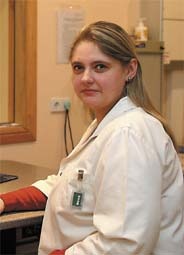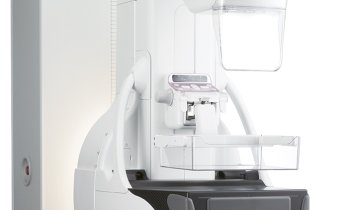Breast cancer screening
20% of all cancers diagnosed annually among Lithuanian women is cancer of the breast. Screening programms should reduce this number.

Among its population of just 3.4 million, 1,300 new cases of breast cancer are diagnosed annually and more than 10 women die from this disease each week. The breast cancer mortality rate is therefore comparatively high: in 2004, it reached 33.5/100,000.
The long-term aim of Lithuania’s screening mammography programme is to reduce the country’s mortality rate from breast cancer. In June 2005, the Ministry of Health approved and began to implement the programme. By the end of the year only 4,500 women had been screened.
Nonetheless, the health authorities proudly state that Lithuania is one of the first countries among new EU members (and the only one in the Baltic States) to deal with this problem at national level.
Aimed at women between 50-69 years, the programme includes information about the value of breast cancer mammography and an invitation for screening, then evaluation. Each woman will be offered screening once a year, then once every two years, which intends to cover about 60% of all women in that age group over two years. According to the State Patient Fund (SPF) 29,700 have been screened in 2006, via 11 participating healthcare institutions. Funded from the SPF budget, the programme is estimated to cover screening costs for over 50,000 women in 2006.
According to Dr Birute Aleknaviciene, head of the Cancer Control and Information Centre at Vilnius University Institute of Oncology, progress in diagnosing I and II stages of breast cancer has been dynamic in the last decade. Ten years ago, only 50% of all diagnosed breast cancers were at those stages; this rose to 66% in 2005. As a member of the programme’s Coordinating Board,
Dr Aleknaviciene predicts it will become 80% in the next decade, and result in a 30% reduction in mortality.
Support from public and business initiatives
Although the programme includes supplying information to individual women, according to data from the SPF the programme’s implementation rate is not optimal. ‘I suppose that, as is the case for other preventive programmes, we have to face the fact that overall awareness of the importance of disease prevention in our country is not very high,’ Dr Aleknaviciene suggests. She regrets that not only patients, but also physicians, are sometimes baselessly sceptical about prevention; they do not recognise the real aim of screening.
This could be supported by data from representative public opinion research, involving over 1,000 responders – more than 50% of them women – that found only 1-in-3 of the women had been checked at least once in a healthcare setting, for possible breast changes, and 1-in-3 had never heard of mammography. Of all female responders in the at-risk age group, only 1-in-4 had received mammography. The survey was conducted for the public initiative group ‘Nedelsk’ (‘Do not delay’), set up in 2003. The group arranges lectures for medical workers, public discussions, shows and solidarity events, encouraging women to change their approach to health and have regular medicals. Most impressive is its Pink Ribbon bus. With crew of medical workers and volunteers, it tours Lithuania, already visiting over 100 towns and villages. Some 24,100 women have been examined within the Do not Delay framework; over 270 were diagnosed with breast cancer symptoms.
Among business supporters, Dr Aleknaviciene mentions a cosmetic sales firm that has organised a fund-raising initiative for new mammography equipment. It also informs customers that a percentage of the cosmetics cost will be used for this, and they supply information about the importance of mammography. ‘With that modern mammography device our institution will perform about 50 mammograms a day - not, as now, 10-15. It is very important for us, because the number and expertise of our specialists far exceeds our screening mammography potential.’ Without this support the institution could not buy the device, she adds, because the SPF’s appraisement covers the net costs of mammography, but nothing more. Equipment handling, maintenance and repair are not included, so no funds could be set aside for a new machine.
Differences at the periphery
Not all available mammography machines are ‘at work’. Of 17, only 11 participate in the screening programme. Dr Ruta Grigiene, head of the radiology department at Vilnius University Institute of Oncology, suggests several reasons. Lithuania is short of radiologists. As a science, radiology is developing so quickly, along with the demand for services, that the number of newly graduated radiologists cannot meet demand. ‘The screening mammography programme also demands that each mammogram must be evaluated by two separate radiologists; some smaller healthcare institutions have only one, so must send for evaluation from another healthcare institution. This creates considerable inconvenience for routine work.’ Dr Grigiene believes that, in future, better balancing of appraisements for mammography procedure and evaluation could produce different expertise for each institution, so that some will concentrate more on mammography imaging, others more on evaluation.
Problems and future adjustment
Problems emerged in the first year of the programme’s implementation. Dr Aleknaviciene believes that, to streamline the programme, it needs responsible coordination. Currently, Coordination Board members are those who established it, and many hold responsible posts in their own institutions, so do not always have time to explain every problem in the process, react quickly and make necessary decisions.
One problems arose with the very first stage of the programme: informing a woman. SPF payment for this service is sent only after the Fund has received a mammogram evaluation. As a result, the primary care institution (usually a general practitioner’s surgery) is unsure that its invested resources will be reimbursed. This separation of reimbursement for informing and performing and evaluating mammograms is not well balanced, and could motivate a healthcare institution to concentrate more on one particular stage. This is particularly important, considering our difficult human resources problem, and that medical specialist are increasingly leaving Lithuania to work abroad.
The programme’s evaluation and correction is anticipated to meet the 5th edition of European guidelines for quality assurance in breast cancer screening and diagnosis (EC publishing date 2007). There will be, for example, more precise criteria to harmonise radiologists’ expertise, to define the number of mammograms evaluated in a certain time period. To improve information, in 2007 the SPF will utilise mass media (radio and TV).
The human factor
A woman’s awareness that she is at age-related risk and therefore needs screening can and does cause anxiety. However, screening can eliminate this. Most women usually receive screening results in 10 days to two weeks, depending on the healthcare institution. According to data from SPF, in an average month 3,500 mammograms are evaluated, and about 60 cases show malignant or possible malignant changes. For those women, further decisions follow their visit an oncology unit and other investigative results. Unfortunately, specialised oncology care is increasingly difficult to access; e.g. at the Oncology Institute of Vilnius University the waiting list runs up to three months - not only psychologically difficult for a patient, but also meaningful for biological changes.
This situation might soon change. ‘The most important thing is that it is recognised and there is a strong wish to change it,’ Dr Aleknaviciene said. ‘The implementation of mammography and other preventive programmes is changing cancer prospects. Already we can see the parting of patient tides. Of course, there are shortages in workplaces and specialists. We cannot spin time in the working day up to infinity; but we do anticipate gradual improvement.’
17.11.2006











